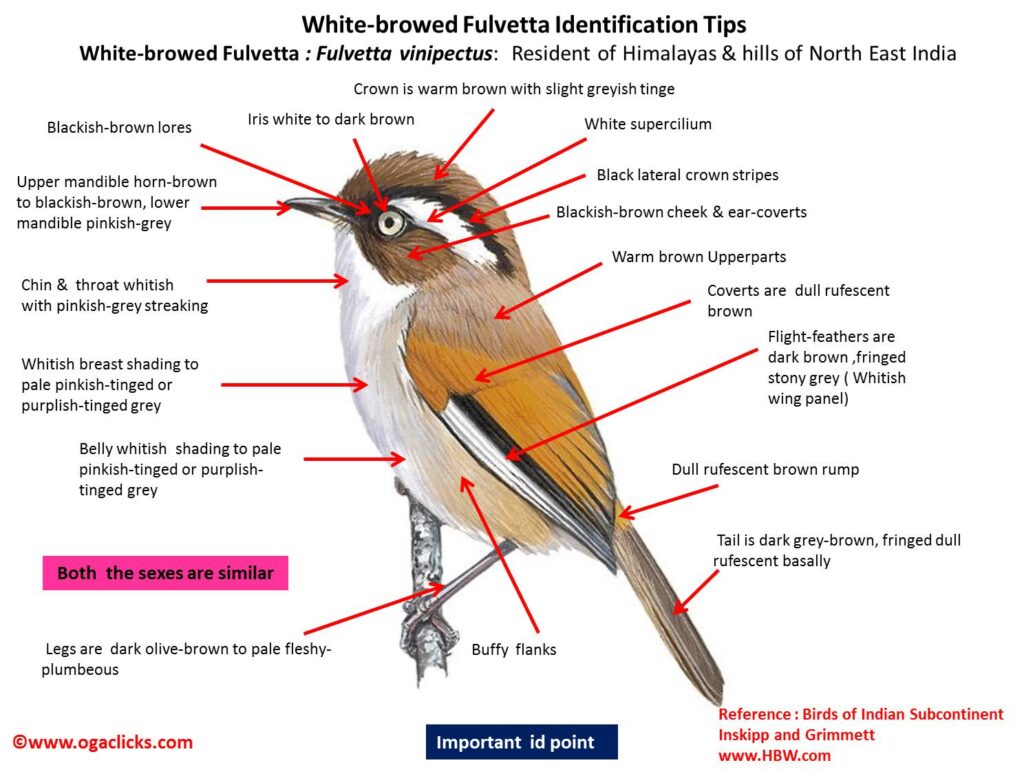
White-browed Fulvetta Fulvetta vinipectus
Etymology:
- Fulvetta: Latin word derived from fulvus – tawny, yellowish-brown.
- Vinipectus : Latin word vinum, vini – wine; pectus -breast.
Vernacular names: Cachar: Dao-pere-gajao
Distribution in India: Resident of Himalayas and North East Indian hills.
Description: Size of 10-11 cm, wt. of 9-13 g. It is a small Fulvetta with soft rich browns and ochrous-buffs with pale eye in dark mask and bold white supercilium. The nominate race has forehead, crown and nape warm brown with slight greyish tinge, bordered by blackish-brown lateral crownstripe above white supercilium from above eye to above ear-coverts; mantle and neck side paler and greyer than crown, scapulars, rump and uppertail-coverts dull rufescent brown; flight-feathers dark brown, outer fringes of upperwing-coverts, tertials and secondaries rufous, outer fringes of inner secondaries stony grey; uppertail dark grey-brown, outer fringes of feathers dull rufescent basally ; lores and cheek blackish-brown, ear-coverts as crown, submoustachial area white with brown stippling; chin, throat and upper breast white , shading to pale pinkish-tinged or purplish-tinged grey on breast, upper belly and upper flanks, rest of underparts pale dull buff; iris white to dark brown ; upper mandible horn-brown to blackish-brown, lower mandible pinkish-grey; legs dark olive-brown to pale fleshy-plumbeous. The juvenile is rustier above than adult, with lateral crown stripes less distinct, flanks are paler. The races differ mainly in plumage tone and pattern, all those E from E Himalayas having supercilium extending forwards to upper bill base: kangrae (North India from Himachal Pradesh to Uttarakhand) has crown and nape warmer brown than nominate, forehead is paler and greyer, chin to breast is cleaner and clearer, area on neck side and upper flanks are pinker; race austeni (North East India from Barail Range, in South Assam, and Nagaland) has head duller brown, lateral crown stripes are more reddish-brown, throat is streaked with reddish-brown; race perstriata (East Arunachal Pradesh), has mantle slightly pinkish or vinous-tinged, breast is pale pinkish-brown, streaks are broader on upper breast.
Habitat: It is found in high-elevation low scrub, juniper, dwarf willow, birch), stunted rhododendron, bamboo, light pine or spruce forest with well-developed scrub layer, forest edge, clearings with plenty of undergrowth, and stunted oak forest. In India found at 2450–3500 m.
Food Habits: It eats insects during breeding season, caterpillars a favorite; also berries and small seeds at other seasons. It is found in flocks, sometimes in association with other species, sometimes including other small babblers. It forages in low trees, bushes and undergrowth.
Breeding Habits: They breed in Apr-Jul in India. The nest is built by both sexes. The nest is a bulky but fairly deep compact cup made of dry grasses, dry bamboo leaves, green moss, rootlets, fibers and birch bark, lined with fine dark grass roots and black or white hair, placed above ground in bush or bamboo or among underbrush. It lays a clutch of 2-3 eggs. The incubation is done by both parents for a period of 2 weeks. The fledging period is 2 weeks. The young fed by both parents.